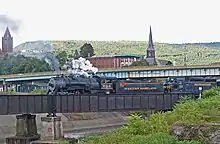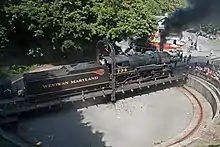Western Maryland 734
The Western Maryland Scenic Railroad No. 734, also known as the "Mountain Thunder", is a preserved class "SC-1" 2-8-0 "Consolidation" type steam locomotive originally built by the Baldwin Locomotive Works in 1916 for the Lake Superior and Ishpeming Railroad. The locomotive was built for service as a dock switcher and was originally LS&I No. 18. In 1924, the LS&I purchased the Munising, Marquette & Southeastern Railroad and the engine was renumbered to No. 34. It served the LS&I until it was retired from revenue service in 1961. In 1963, it was sold to the Marquette and Huron Mountain Railroad, but never operated under the M&HR flag. In 1971, the locomotive was sold to the Illinois Railway Museum for static display. Today, the 734 is owned and operated by the Western Maryland Scenic Railroad in Cumberland, Maryland; however, as of 2021, the locomotive is stored unserviceable, awaiting for a 1,472-day FRA-required boiler inspection.
| Western Maryland 734 | |||||||||||||||||||||||||||||||||||||||||
|---|---|---|---|---|---|---|---|---|---|---|---|---|---|---|---|---|---|---|---|---|---|---|---|---|---|---|---|---|---|---|---|---|---|---|---|---|---|---|---|---|---|
.jpg.webp) WMSR No. 734 at the Cumberland Station in 2006 | |||||||||||||||||||||||||||||||||||||||||
| |||||||||||||||||||||||||||||||||||||||||
| |||||||||||||||||||||||||||||||||||||||||
| |||||||||||||||||||||||||||||||||||||||||
| |||||||||||||||||||||||||||||||||||||||||
History
Original Service Life
_(14573973250).jpg.webp)
In the 1900s, the Lake Superior and Ishpeming railroad[1] needed locomotives to pull passenger and iron ore trains between West Ishpeming and Marquette, Michigan.[2] They had a group of 2-8-0 consolidation types[3] at the time, including two class B-4s built in 1902, which were rated at approximately 43,304 pounds of tractive effort, but the railroad decided to supplement them with a new design of a 2-8-0 consolidation from the American Locomotive Company (ALCO) in Pittsburgh, Pennsylvania, a class B-4 No. 14, replacing an 1880's-built 0-4-0 that was also numbered 14. It proved to be the most powerful consolidation of its time, being capable of pulling up to 45 loaded hoppers on a %1.6 grade between Marquette and Negaunee.
In 1909, the railroad ordered five more 2-8-0 locomotives from ALCO, and they arrived the following year, being numbered 9-13. The newer locomotives had smaller boilers than the B-4, and they weren't quite as powerful, either, as they were only capable of 34,000 pounds in tractive effort. However, they were still capable for mixed services. When the Pittsburg facility was shut down, and as World War I broke out, the LS&I decided to get locomotives larger and more powerful than what they had, because the ore business kept on rising. And so, they went to the drawing board to create a 'step up' of the B-4s, a locomotive with an 88'' diameter boiler, cylinder dimensions of 26'' x 30'', an engine weight of 270,000 pounds, and a tractive effort of 55,900 pounds.
The railroad ordered these newly designed locomotives from Baldwin Locomotive Works of Philadelphia, Pennsylvania, and they were numbered 18-20, and one more was purchased by the Munising, Marquette and Southeastern Railway, bringing the total number of these giants to four. Since both the sand domes and steam domes were squashed flat, and their bells were mounted on the sides of their boilers, they were earned the name "hogs", an epithet which they still hold. These giants also hold a distinction for being the largest and most powerful 2-8-0 locomotives in the world, as well as the most powerful locomotives in Northern Michigan, even though they didn’t go very fast. While the B-4s could pull 45 loaded hoppers on a %1.6 grade, the hogs could pull up to 60 loaded hoppers up on that same grade without a hitch. That’s more than any other consolidation have ever done before. Because of this, the hogs succeeded the B-4s to work "day in and day out" on the hill to the ore range.
In 1924, the LS&I received some additional 2-8-0s, including that road's one hog, after purchasing the Munising, Marquette and Southeastern Railway, so a renumbering system and reclassification system were in order; the B-4s were reclassified as SC-3s and were renumbered 25-29, 9-13 were reclassified as SC-4s and renumbered 18-25, and the hogs were reclassified as SC-1s, while being renumbered 30-33. The 18 was renumbered 30, and the number 18 was given to an SC-4 class. Just one year later, the railroad purchased two more heavy 2-8-0s from the Chicago River and Indiana Railroad, and No. 30 was renumbered 34. Until the arrival of the LS&I's 2-10-2 "Santa Fe" types in 1930, the SC-1s remained as the backbone of the LS&I's mainline ore services. These husky hogs resumed muscled heavy car loads of iron ore and passenger trains on the Michigan short line, but they were unfrequently used during the winter. No. 34 was in charge of the pinch-hitting for diesel locomotives, especially when her classmates are under repair. This career for the locomotives ended, when the LS&I even decided to fully dieselize by the early 1960s. No. 34 was retired in 1961, and it was stored near Marquette. The LS&I ended all steam operations the following year.
In 1963, the railroad sold twelve of their 2-8-0s, as well as some of their passenger cars, to the Marquette and Huron Mountain Tourist Railroad.[4] Even then, there are no known records of the 34 pulling any trains for that railroad. Only some of the SC-4s, Nos 19, 22, 23, and 24, were known to pull tourist trains there between Marquette and Big Bay.[5] Instead, No. 34 sat with the rest of her sisters in the form of a 'scrapline', until 1971. That year, No. 34 was sold to the Illinois Railway Museum in Union, Illinois, where it remained on static display for the next twenty years.
Western Maryland Scenic Railroad
The Western Maryland was a railroad that served a small town called Cumberland, Maryland along with a branch line that ran between there and Frostburg, as well as stretching to other small towns, like Hancock and Connellsville. In 1973, though, that said branch line was abandoned and mostly ripped up, as one year prior, the WM joined the Baltimore and Ohio and Chesapeake and Ohio railroads to group into the Chessie System, which would eventually be completely merged into the new CSX transportation system. In the late 1980s, the City of Cumberland started seeing the old branch line as a possible tourist attraction,[6] so a joint effort was formed; Allegany County ponied up $585,000, the city $2,470,560, and the city of Frostburg $338,427 to purchase the corridor. As part of the deal, the Allegany Central Railroad was given the old WM shops in Ridgeley, West Virginia, a 1913 built Station in Cumberland, and an 1891 built Cumberland & Pennsylvania wooden depot in Frostburg.
During this acquisition of course, the tourist railroad was looking for locomotives to pull the trains. Some of the first locomotives they used were Canadian Pacific 4-6-2 "pacific" types 1238 and 1286.[7] Soon, the Allegany Central was moved to Staunton, Virginia to make way for Scenic Railroad Development Corporation's newly founded Western Maryland Scenic Railroad. The steamer they acquired was the 34, which was taken away from the Illinois Railway Museum in 1991. Later that year, restoration work began while a few modifications were given.[8] The small four-axle tender was replaced with a bigger six-axle tender that used to belong to New York Central 4-8-2 "Mohawk" No. 2662 for better coal and water capacity, and the original tender was also badly damaged in a fire, creating a huge hole in the water bunker. Other notable modifications include the headlight being relocated to the center of the smokebox door, a new 'Rock Knocker' cowcatcher, a replacement bell that used to belong to Western Maryland H-9 No. 816, and of course, she was renumbered 734. These modifications were intended to make the locomotive represent the Western Maryland's own series of 2-8-0s, none of which survived the scrapper's torch. Although this is now numbered after an original H-7a No. 734, the locomotive also now has an appearance of an H-9.
Restoration work was completed in 1993, and No. 734 was ready to start it's new career as a tourist steam locomotive. While operating for the new scenic line, No. 734 was earned the nickname 'Mountain Thunder', as it turns out not only was it now the largest active steam locomotive with a 2-8-0 wheel arrangement, but it was also the largest active steam locomotive in the state of Maryland. She is also homed in a mountain range. The scenic railroad's new star was normally used to pull passenger trains, as well as occasional freight trains between Cumberland Station and Frostburg Station, and on every return trip to Cumberland, there's a turntable in Frostburg, so it was quite rare for the engine to go backwards while hauling a train. In September 2013, the scenic railroad was visited by 0-4-0 tank engines Viscose Co 6 and Flagg Coal Co 75, and they operated alongside No. 734 and stayed for a night photo session for the 25th anniversary of the grand re-opening of the tourist line.[9] The following month, No. 734 was temporarily renumbered 729[10] to pay tribute to another long lost WM 2-8-0, and this was for a photo session of the locomotive pushing and pulling freight.[11]

In 2014, the WM Scenic Railroad[12] announced that they would purchase Chesapeake and Ohio 2-6-6-2 "Mallet" No. 1309[13] from the B&O Railroad Museum in Baltimore, Maryland, and restoration work for the locomotive began. Considering how big the 1309 is, it would rob No. 734 as the largest active steam locomotive in Maryland. In 2015, the Scenic Railroad announced that No. 734 was going to be taken out of excursion service, as she was getting close to being due for a mandated 1,472-day boiler inspection required by the Federal Railroad Administration (FRA).[14] It made its last passenger run on 26 September 2015,[15] and after hauling one last freight train on 9 April 2016,[16] roughly the locomotive's 100th birthday, Mountain Thunder was silenced.
As of 2020, No. 734 sits idle on a side line by the WM's Ridgeley shops with her tender uncoupled, and the consolidation can't fit inside the shops, as No. 1309 alone is long enough to fill up most of the limited space. Employees say that once restoration work on the 1309 is finished, the FRA required rebuild for the 734 will take place.[17]
See also
External links
Further reading
- Unknown Author(1916). Railway and Locomotive Engineering; A Practical Journal of Motive Power, Rolling Stock and Appliances: Volume 29. Classic Reprint Series ISBN 978-1334191183
References
- Durocher, Aurele A. (1958). "The Lake Superior and Ishpeming Railroad Company". The Railway and Locomotive Historical Society Bulletin (98): 7–31. ISSN 0033-8842.
- "Lake Superior & Ishpeming Railroad: History/Map/Photos". American-Rails.com. Retrieved 2020-11-14.
- "Lake Superior & Ishpeming 2-8-0 "Consolidation" Locomotives in the USA". www.steamlocomotive.com. Retrieved 2020-11-30.
- "Marquette & Huron Mountain Railroad". www.railroadmichigan.com. Retrieved 2020-11-17.
- "Old_MHM". algomacentral.railfan.net. Retrieved 2020-12-21.
- "Western Maryland Scenic Railroad". American-Rails.com. Retrieved 2020-11-19.
- "Allegheny Central's Jack Showalter inspired many - Trains Magazine - Trains News Wire, Railroad News, Railroad Industry News, Web Cams, and Forms". cs.trains.com. Retrieved 2021-01-05.
- "Steam Locomotive Information". www.steamlocomotive.info. Retrieved 2020-11-19.
- Times-News, Greg LarryCumberland. "Two classic train engines arrive for 25th anniversary". The Cumberland Times-News. Retrieved 2020-11-22.
- "Western Maryland #729 - Second Set". Trainorders.com Discussion. Retrieved 2020-11-22.
- "Store". Vintage Trains | DVDS, CDS, Video on Demand. Retrieved 2020-11-22.
- "HawkinsRails - Western Maryland Scenic Railroad". hawkinsrails.net. Retrieved 2020-11-22.
- "1309 Restoration | Western Maryland Scenic Railroad". Western Maryland Railroad. Retrieved 2020-11-22.
- "| FRA". dotcms.fra.dot.gov. Retrieved 2020-11-22.
- "WM 734". www.rrpicturearchives.net. Retrieved 2020-11-22.
- "Railway Preservation News • View topic - WMSR 734 Last Runs". www.rypn.org. Retrieved 2020-11-22.
- Times-News, KRISTIN HARTY BARKLEY | Special to the. "Sights set on steam: Return of locomotive No. 1309 expected to be big draw for tourists to Western Maryland Scenic Railroad". The Cumberland Times-News. Retrieved 2020-11-22.
